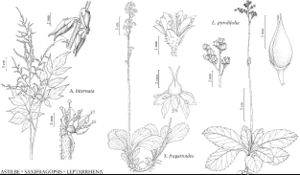Difference between revisions of "Saxifragopsis"
Bull. Torrey Bot. Club 23: 19, plate 257. 1896 ,.
FNA>Volume Importer |
FNA>Volume Importer |
(No difference)
| |
Revision as of 23:01, 16 December 2019
Herbs rhizomatous, not stoloniferous; rhizome woody, sometimes slightly elongated. Flowering stems erect, leafless, 6–25 cm, stipitate-glandular, hairs unicellular. Leaves in basal rosette and cauline; cauline leaves 1–2, reduced distally to sessile bracts; stipules barely expanded petiole bases; petiole jointed distally at attachment to blade, separating early from blade, sparsely stipitate-glandular; blade broadly obovate-cuneate, not lobed, base cuneate, ultimate margins coarsely 7–11-toothed distally, ciliate, apex acute to obtuse, surfaces glabrous or scantily stipitate-glandular; venation palmate. Inflorescences compact thyrses, terminal from terminal bud in basal rosette, 27–90-flowered, bracteate. Flowers: hypanthium adnate to ovary in proximal 1/2, free from ovary 0.2 mm, greenish; sepals 5, green; petals 5, white, unlobed; nectary tissue inconspicuous or absent; stamens 10; filaments filiform; ovary 1/2 inferior, 2-locular, carpels connate in proximal 1/4; placentation axile; styles 2, (distinct); stigmas 2. Capsules 2-beaked. Seeds brown, ovoid-prismatic, smooth or ribbed. x = 7.
Distribution
w United States.
Discussion
Species 1: w United States.
Features of Saxifragopsis that make it discordant within the relatively large and diverse genus Saxifraga include the thick, woody rhizome; early separation of the leaf blade from its joint with the petiole; unicellular, glandular trichomes; and beaklike form of the styles having no counterparts in Saxifraga, although that is where the single species of Saxifragopsis is most often placed (P. A. Munz 1968).
Species 1
Selected References
None.
